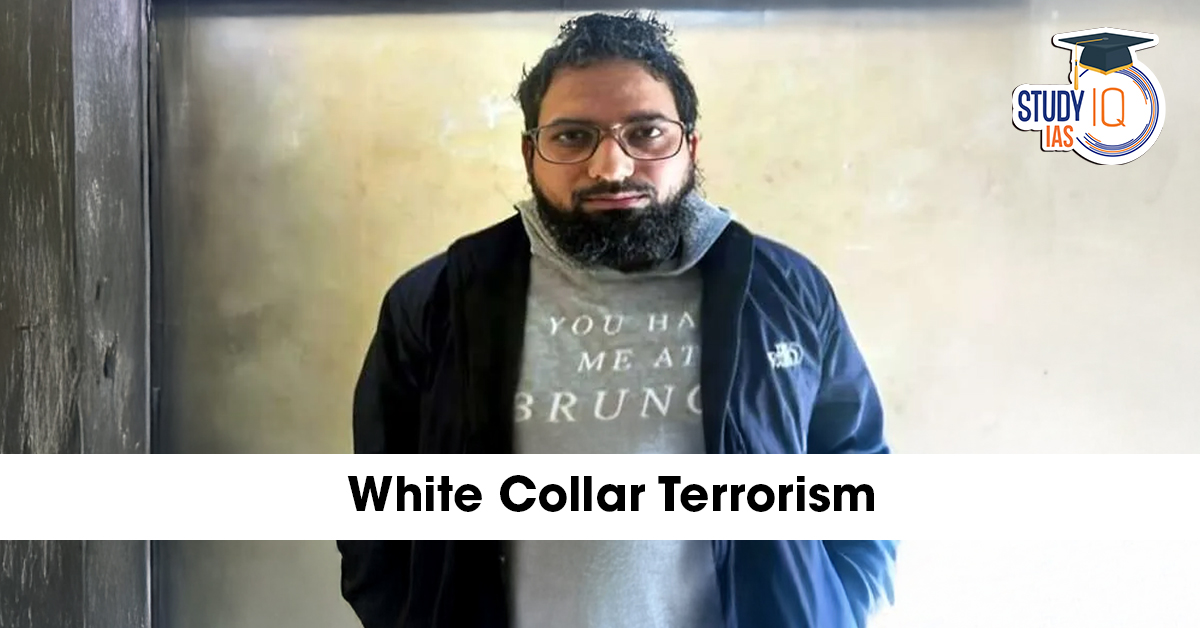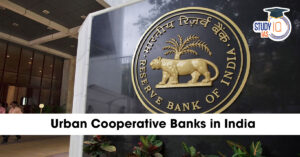Table of Contents
White-collar terrorism refers to extremist activities carried out by educated professionals—such as doctors, engineers, professors, research scholars, IT experts, and corporate employees—who use their skills, networks, and social credibility to plan, support, or execute terror operations.
Unlike conventional militants, white-collar terrorists:
-
Operate through professional and academic networks
-
Enjoy minimal scrutiny due to trusted social status
-
Use legitimate credentials to mask radical activities
-
Facilitate funding, logistics, recruitment, and reconnaissance
This makes white-collar terror networks harder to detect and significantly more dangerous.
Why Is White-Collar Terrorism in the News?
A major India-wide counterterrorism operation (2025) uncovered a trans-state terror module involving radicalised doctors linked to:
-
Jaish-e-Mohammed (JeM)
-
Ansar Ghazwat-ul-Hind (AGuH)
-
Islamic State – Khorasan Province (ISKP)
The module was connected to:
-
The Red Fort blast
-
A massive Faridabad explosives haul (2,900+ kg)
-
Radicalisation and recruitment cells operating through universities
This marked one of India’s largest white-collar terror crackdowns.
Key Suspects: How Doctors Became Terror Operatives
Investigations revealed five doctors across Kashmir, Uttar Pradesh, Haryana, and Telangana involved in the terror ecosystem.
1. Dr Muzammil Ganaie – Mastermind Candidate (Pulwama)
-
MBBS faculty at Al-Falah University, Faridabad
-
358 kg of ammonium nitrate recovered from his room
-
Additional 2,563 kg found in nearby safe houses
-
Weapons recovered: Krinkov rifle, pistols, timers, detonators
2. Dr Adeel Ahmad Rather – Arms Handler (Kulgam)
-
Linked to JeM module
-
AK-47 recovered from a medical locker
-
Helped manage storage and movement of arms
3. Dr Shaheen Sayeed – Recruiter (Lucknow)
-
Accused of coordinating networks and helping transport arms
-
Assault rifle dumped after panic during arrests
4. Dr Umar Mohammad – Suspected Bomb Carrier (Pulwama)
-
Allegedly driving the car that exploded near Red Fort
-
Still absconding; believed to be key logistician
5. Dr Ahmed Mohiyuddin Saiyed – ISKP-Linked Operative (Hyderabad)
-
Delivered weapons through drones from Pakistan
-
Seized: Glocks, Beretta, ammunition, castor-bean mash (used to make ricin)
-
Conducted reconnaissance in multiple cities
These arrests exposed how highly educated individuals were embedded inside medical colleges, hospitals, and research environments.
Modus Operandi of White-Collar Terror Networks
1. Exploiting Professional Cover
Professionals easily justify:
-
Frequent travel
-
Large deliveries to hostels/hospital storage rooms
-
Procurement of regulated chemicals
-
Access to labs and equipment
This reduces suspicion.
2. Using Academic Institutions as Safe Zones
Terror modules used:
-
University labs
-
Faculty quarters
-
Medical hostels
…to store explosives, meet handlers, and plan operations.
3. Encrypted Digital Ecosystems
Terror operatives coordinated via:
-
Telegram
-
Signal
-
Encrypted VoIP calls
-
Virtual private servers (VPS)
-
Social media radicalisation pipelines
4. Professional Networking for Recruitment
Radicalised doctors targeted:
-
Students
-
Junior colleagues
-
Women (for logistical roles)
5. Financial Movement Through Charitable Fronts
Funds were transferred via:
-
Crowdfunding
-
NGO-style entities
-
Digital wallets
-
Cryptocurrencies
-
Hawala channels
6. Drone Deliveries & Cross-Border Coordination
Pakistani handlers used drones to deliver:
-
Pistols
-
Improvised explosive device (IED) components
-
Cash packets
This indicates high operational sophistication.
Why White-Collar Terrorism Is More Dangerous
1. Harder to Detect
Professionals carry trusted identities and rarely attract suspicion.
2. Access to Chemicals & Lab Facilities
Explosives like ammonium nitrate and toxic agents like ricin can be synthesized or stored discreetly.
3. Ability to Build Large, Multi-State Networks
Doctors and academics often work across states, enabling seamless movement.
4. Potential for High-Intensity Attacks
The seized 2,900+ kg of explosives indicates planning for catastrophic, multi-target attacks.
5. Radicalisation of Influential Individuals
Doctors hold social authority, which terrorists exploit to recruit others.
National Security Implications for India
The emergence of white-collar terrorism poses new challenges:
1. Need for Stronger Screening in Academia
Universities must enhance:
-
Verification processes
-
Monitoring of chemical access
-
Cybersecurity systems
2. Dedicated Counter-Radicalisation Programs
Particularly in:
-
Professional colleges
-
Medical institutions
-
Technical universities
3. Multi-Agency Coordination
Police, NIA, IB, ATS, and cyber agencies must collaborate seamlessly.
4. Monitoring of Cross-Border Digital Influence
Pakistan-linked radicalisation pipelines require stronger disruption.
5. Strengthening Regulation of Chemicals
Better tracking of:
-
Ammonium nitrate
-
Lab-grade reagents
-
Toxic substances
White-Collar Terrorism vs Traditional Terrorism
| Feature | White-Collar Terrorism | Traditional Terrorism |
|---|---|---|
| Operatives | Educated professionals | Trained militants |
| Cover | Professional identity | Underground networks |
| Detection Difficulty | Very High | Moderate |
| Radicalisation Route | Online, academic networks | Local cells, training camps |
| Resources | Labs, institutions, digital tools | Arms caches, training areas |
White-collar terror operates with corporate-style precision.
Conclusion
White-collar terrorism represents the next phase of extremist threat in India.
Radicalised doctors, engineers, and academics merging professional expertise with terrorist intent create a highly sophisticated, well-camouflaged ecosystem that challenges conventional counterterror strategies.
India’s recent crackdown has averted multiple large-scale attacks, but the trend highlights the urgent need for:
-
Institutional vigilance
-
Digital surveillance
-
Counter-radicalisation
-
Strict monitoring of chemical access
White-collar terrorism is no longer a theoretical concept—it is a clear, present, and evolving threat.


 Transplantation of Human Organs and Tiss...
Transplantation of Human Organs and Tiss...
 Dumpsite Remediation Accelerator Program...
Dumpsite Remediation Accelerator Program...
 Urban Cooperative Banks (UCBs) in India:...
Urban Cooperative Banks (UCBs) in India:...

























